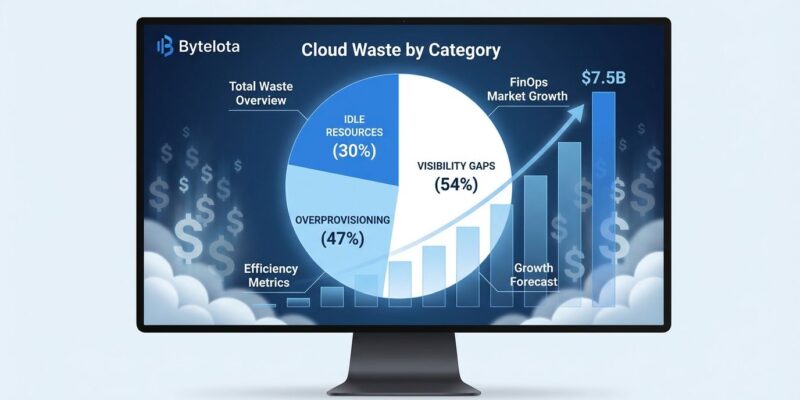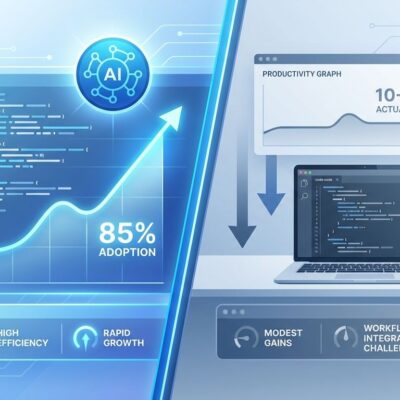
Cloud waste has reached epidemic proportions in 2025: organizations are throwing away 30-47% of their cloud budgets—over $200 billion wasted annually across the industry. With global public cloud spending projected to hit $723.4 billion this year (up 21.5% from 2024) and 82% of companies reporting higher-than-expected bills, the cloud cost crisis isn’t a future problem. It’s burning through budgets right now. The culprits aren’t technical failures but organizational ones: lack of visibility, overprovisioning, idle resources, and a fundamental disconnect between developers who make architectural decisions and FinOps teams trying to control costs.
The Five Drivers of Cloud Waste: Why 30-47% Disappears
Cloud waste stems from five organizational failures, each contributing to the staggering 30-47% waste rate. The biggest culprit is idle resources, responsible for 66% of waste causes. Non-production resources—dev and test environments—account for 44% of cloud spend but run 128 hours per week when they’re only needed for 40. That’s 76% idle time, racking up charges around the clock.
Overprovisioning comes in second, causing 59% of waste. Developers provision for maximum load rather than actual usage, preferring safety margins over efficiency. The result: Kubernetes clusters running at 30-50% utilization, wasting 50-70% of capacity. One infrastructure team found their production cluster consistently used just 35% of provisioned resources—the other 65% was paying rent for doing nothing.
Lack of visibility drives 54% of waste. Only 30% of organizations understand where their cloud budgets actually go, and 78% detect cost anomalies hours or days too late. Fewer than half of developers have real-time access to basic cost data: just 43% can see idle resources, 39% can spot unused volumes, and only 33% know which workloads are over or under-provisioned.
The developer-FinOps disconnect is costing the industry $44.5 billion in 2025 alone. Here’s the gap: 62% of developers want cost control, but only 32% have automated practices to achieve it. The numbers reveal the breakdown: 71% don’t use spot orchestration, 61% skip rightsizing, 58% ignore reserved instances, and 48% don’t even track idle resources. Developers simply don’t view cost optimization as their priority, leading to overprovisioned resources and inefficient architectures that quietly drain budgets.
Related: Kubernetes Is Overkill: Why Companies Are Ditching K8s
Real-World Cloud Cost Optimization: Companies Cut 20-40%
Companies implementing systematic FinOps strategies achieve 20-40% total cost reductions. The path is tiered, starting with quick wins and scaling to strategic transformation.
TechNova cut monthly cloud spend by 30% ($60,000) in March 2025, projecting $720,000 in annual savings. Their cost per customer dropped 45%, and network costs plummeted 60%—all without compromising performance or reliability. A digital banking app reduced per-feature deployment costs by 38% and improved forecast accuracy by 55% after adopting Cloudability and creating a dedicated FinOps team. Even simple wins deliver massive returns: one company achieved 65% cost reduction on 100 AWS test VMs just by shutting them down outside business hours.
The three-tier strategy works like this: Quick wins (6-14% savings) come from shutdown policies, orphaned resource cleanup, and idle resource termination. Targeted optimization (8-20% savings) involves rightsizing, commitment optimization through reserved instances and savings plans, and storage tiering. Strategic initiatives (20-40% total savings) require cultural transformation: building FinOps culture, shifting cost responsibility left to developers, and architecting for cloud-native efficiency from the start.
Here’s what matters: every $100,000 in cloud spend contains $30,000 to $47,000 in recoverable waste. For startups, that’s hiring budget. For enterprises, it’s millions redirected from infrastructure overhead to innovation.
The Developer Responsibility Gap: 62% Want Control, Only 32% Have It
There’s a massive gap between developer desire and reality. 62% of developers want control over cloud costs. Only 32% have the automated practices to exercise that control. This disconnect is projected to waste $44.5 billion in infrastructure spend in 2025, with 52% of engineering leaders citing it as the primary driver of wasted cloud costs.
The implementation gaps reveal the problem. 71% of developers don’t use spot orchestration. 61% don’t rightsize instances. 58% skip reserved instances and savings plans entirely. 48% don’t even track and shut down idle resources. It’s not ignorance—it’s priorities. Developers focus on shipping features, not optimizing cloud bills. Cost optimization gets treated as “someone else’s job.”
The visibility gaps compound the issue. Fewer than half have access to the data they’d need to optimize costs: 43% can’t see idle resources in real-time, 39% can’t identify unused volumes, and just 33% have visibility into over or under-provisioned workloads. How can developers optimize what they can’t measure?
The cultural shift is clear: cloud cost management is moving left. Architectural decisions—serverless vs containers, instance types, auto-scaling configurations—directly impact spend. FinOps isn’t an ops problem anymore. It’s a core developer skill, and companies that recognize this are cutting costs while competitors burn cash.
The FinOps Market Explosion: From Cost-Cutting to Strategic Imperative
The FinOps market hit $5.5 billion in 2025, growing at 34.8% CAGR. This isn’t a niche anymore—67% of CIOs identify cloud cost optimization as a top IT priority. The market is expanding beyond infrastructure to include SaaS, software licensing, private cloud, and data centers. 63% of FinOps teams already manage AI and GPU spend, the fastest-growing cost category.
The tool landscape reflects this maturity. CloudHealth charges roughly 3% of cloud spend for enterprise-grade multi-cloud management. Apptio Cloudability (now IBM) costs 2-3% of spend and excels at complex chargeback structures and financial system integrations. CloudZero takes a different approach at $19 per month per $1,000 spend, focusing on unit economics: cost per customer, cost per feature, cost per daily active user. The shift from infrastructure metrics to business metrics signals FinOps maturity.
The shift-left movement is gaining momentum. 57% of FinOps practitioners plan to adopt FOCUS (FinOps Open Cost and Usage Specification) in the next 12 months, standardizing cost data across cloud providers. Cost estimation tools like Infracost are becoming standard in CI/CD pipelines, catching expensive architectural decisions before deployment rather than discovering them in next month’s bill.
GreenOps: When Cloud Costs Meet Carbon Management
The convergence of FinOps and GreenOps is transforming cloud optimization from cost management to a dual cost-carbon strategy. The new ISO/IEC 21031 standard for Software Carbon Intensity (SCI), adopted in 2024, puts carbon measurement on CFOs’ radars. The most mature organizations are blending FinOps with GreenOps to optimize both metrics simultaneously.
Carbon-aware computing is moving from theory to practice. Platforms now automatically shift non-urgent training jobs to time windows when renewable energy dominates the grid. Organizations embed carbon intensity (gCO₂e) alongside cost in dashboards, treating both as first-class metrics. Workloads adjust when and where they run based on electricity carbon intensity—doing more when the grid is clean, less when it’s dirty.
The business case is straightforward: cost optimization and carbon reduction often align. Less waste means fewer emissions. As ESG reporting requirements grow, developers who understand carbon-aware architecture will have a competitive advantage. It’s not just good for the planet—it’s becoming a regulatory requirement and a talent differentiator.
Key Takeaways: What Developers Can Do Today
- Cloud waste hits 30-47% of budgets ($200B+ annually), driven by idle resources (66%), overprovisioning (59%), lack of visibility (54%), and the developer-FinOps disconnect ($44.5B wasted in 2025)
- Companies implementing FinOps achieve 20-40% cost reductions: quick wins yield 6-14% (shutdown policies, cleanup), targeted optimization gets 8-20% (rightsizing, commitments), strategic transformation captures the full 20-40%
- 62% of developers want cost control but only 32% have automated practices—this gap is the core problem, not the technology
- Start with quick wins this week: shutdown dev/test outside working hours (65% savings proven), delete orphaned volumes, tag everything for visibility
- FinOps is shifting left: cost estimation in CI/CD, pre-deployment guardrails, and cloud-native architectures are becoming standard developer skills, not optional ops concerns
- The FinOps market ($5.5B, 34.8% CAGR) is converging with GreenOps (ISO 21031 carbon standard), making cost-carbon dual optimization a competitive advantage
Cloud costs are a developer responsibility now, not an ops afterthought. Every architectural decision—serverless vs containers, instance types, auto-scaling configs—impacts spend. The good news: you don’t need executive buy-in to start. Tag your resources. Shutdown dev environments after hours. Use spot instances for batch jobs. Small wins build momentum and prove ROI for bigger FinOps investments. Every $100K in cloud spend contains $30-47K in recoverable waste. That’s hiring budget, feature development, or runway. Stop burning it.











